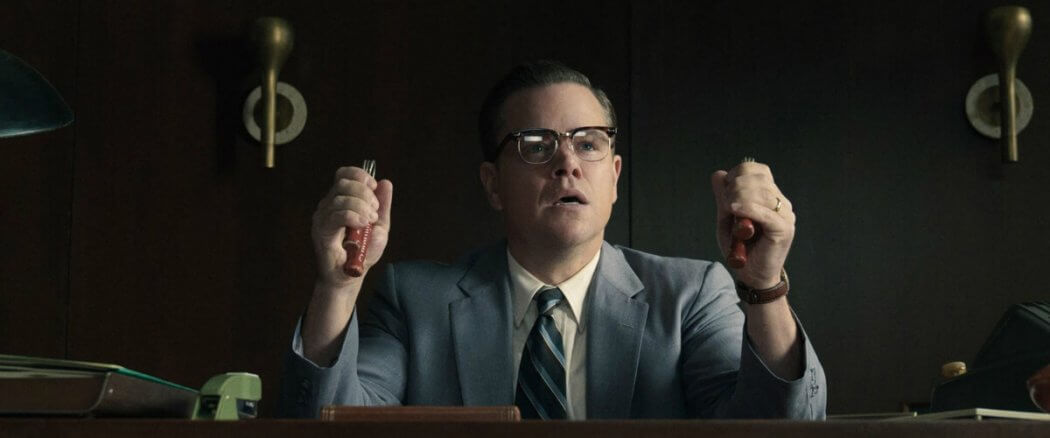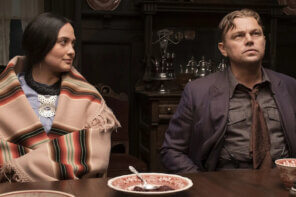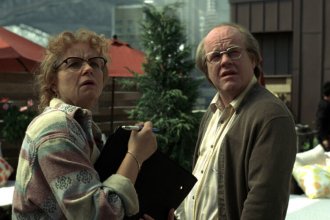Suburbicon’s depiction of the 1950’s portrays an iconic American vision beneath the subterfuge of which lie corruption and moral decay. An uneven blend of social commentary and pulp fiction, the film attempts to connect two unrelated narratives by employing the visual motif of a fence that separates the homes of Gardner Lodge and Mr. and Mrs. Mayers, the first colored family to integrate the titular neighborhood. When the film opens, an advertisement presents Suburbicon as a diverse Camelot of the ultimate American melting pot. Ironically, though, we see that the diversity this suburban paradise boasts never penetrates racial lines. That’s right, folks…this ideal community draws all kinds of people from across state boundaries, but not ethnic distinctions.
Two Families
A Leave it to Beaver-esque tone undergirds the opening scene as we follow the classic congenial mailman going about his usual route, gleefully greeting all the familiar neighbors in this safe, pristine suburb until his demeanor literally drops upon discovering that the Black woman who receives the mail addressed to Mrs. Mayers is not in fact the maid, but the matriarch of the house herself. From this point on, Suburbicon’s lily white façade diminishes, an angry town hall meeting ensues, neighbors vehemently express their disgust at integration, and we consequently see a progressive tension of threats and harassment replete with marching bands and throngs of pious citizens singing religious hymns — a mass demonstration that ultimately eventuates in the riotous destruction of the Mayer home. The kind residents of this picturesque Mayberry-like town manifest and project onto their new neighbors the very societal disintegration they feared would occur as the result of what they perceived as an African American invasion — or as Public Enemy so eloquently put it when titling their epic 1990 album…fear of a Black Planet!
![]() Paralleled with this based-on-true-events vignette is Gardner’s story. Matt Damon portrays a typical middle class business professional burdened by mafia debt and consequently ensnared in a plot to kill his wife, cash in on her insurance policy, and relocate to Aruba with his complicit mistress who happens to be his wife’s twin sister (Julianne Moore incidentally portrays both characters). Reminiscent of vintage 1940’s film noir like The Postman Always Rings Twice and Double Indemnity, the plot also calls to mind 1996’s Fargo — not surprising as director George Clooney basically referenced a 1986 Joel and Ethan Coen script when assembling this film. Note the resemblance to the aforementioned Midwest crime thriller: (1) Husband pays thugs to harm his wife, (2) the plan goes awry, (3) the husband becomes reluctant to pay the anxious criminals who in turn intensify their demand for payment, (4) the suspect gets a visit and/or phone call at work from both the police and the criminals, (5) suspect attempts to play stupid when questioned by the police (6) and the sin the perpetrators indulged becomes more consequential than that for which they bargained. Suburbicon adds this bizarre, subtle difference (Spoiler Alert): after Gardner’s wife, Rose, dies and her twin Margaret moves into the home to occupy her space, he gradually begins to transform her into her deceased sister — he dies her hair blonde, dances with her in the living room, and engages in kinky sex in the basement…she even takes on an eerie motherly role toward Gardner’s son and her nephew, Nicky (Noah Jupe).
Paralleled with this based-on-true-events vignette is Gardner’s story. Matt Damon portrays a typical middle class business professional burdened by mafia debt and consequently ensnared in a plot to kill his wife, cash in on her insurance policy, and relocate to Aruba with his complicit mistress who happens to be his wife’s twin sister (Julianne Moore incidentally portrays both characters). Reminiscent of vintage 1940’s film noir like The Postman Always Rings Twice and Double Indemnity, the plot also calls to mind 1996’s Fargo — not surprising as director George Clooney basically referenced a 1986 Joel and Ethan Coen script when assembling this film. Note the resemblance to the aforementioned Midwest crime thriller: (1) Husband pays thugs to harm his wife, (2) the plan goes awry, (3) the husband becomes reluctant to pay the anxious criminals who in turn intensify their demand for payment, (4) the suspect gets a visit and/or phone call at work from both the police and the criminals, (5) suspect attempts to play stupid when questioned by the police (6) and the sin the perpetrators indulged becomes more consequential than that for which they bargained. Suburbicon adds this bizarre, subtle difference (Spoiler Alert): after Gardner’s wife, Rose, dies and her twin Margaret moves into the home to occupy her space, he gradually begins to transform her into her deceased sister — he dies her hair blonde, dances with her in the living room, and engages in kinky sex in the basement…she even takes on an eerie motherly role toward Gardner’s son and her nephew, Nicky (Noah Jupe).
Two Disconnected Stories
Not only do Clooney and his assistant writer/producer Grant Heslov fail to organically and intelligibly unite two stories, but there persists a not so subtle lack of consistency in character and narrative development for both. We never gain any insight into the subjective world of Mr. or Mrs. Mayers. Only the mother and her son, Andy (portrayed by Tony Espinosa), have any actual dialogue and the former’s most engaging scene occurs in a grocery store where we awkwardly share in her demeaning experience as the manager berates her and implies that she would enjoy her shopping experience elsewhere. But we never observe her processing this moment. How did she work through all the emotional and psychological implications of such a humiliating encounter? What was the conversation she had with her family? We get a few lines from Andy as he shares with Nicky that his dad encouraged the family to “never let them see you afraid.” The film’s editing poorly attempts to parallel the families: we get a shot of Rose directing a frightened Nicky (the protestor’s clamor compounds night after night) to pray to patron saints, but when we see Mrs. Mayers praying with her son, we get no disclosure into what exactly she’s saying to comfort him. We observe the Mayers watching TV together as a family attempting to ignore the epithets and hostile taunting of the rioters outside, but we never scratch the surface of any of kind of multidimensional character development — we never get to know the Mayers as people.
One Fence
As alluded to in the introduction, a fence connects the neighboring homes in which contrasting realities unfold — in the White household, betrayal, murder, adultery, and illegal activity spiral out of control and culminate in a macabre slapstick-like string of events that exponentially compound in absurdity and tragic irony. Meanwhile, next door, a quaint, peaceful family continues in a mundane routine of typical hanging laundry on clotheslines, mowing the lawn, and having family dinner while unprovoked terrorism inevitably brings about total and unwarranted domestic chaos for them.
![]() I find it interesting that the film utilizes fences to both symbolize division as well as redemptive hope. Signifying the essential American Dream of home ownership and of having “made it” in capitalistic American culture, a fence divides the Lodges’ and Mayers’ yards. Simultaneously, the good citizens of Suburbicon build another fence to isolate, ostracize, and alienate the pioneering Black family. But it is also across a fence that we see redemptive hope burgeoning in the friendship that develops early on between Nicky and Andy. Urged in the film’s opening act by his mother, Nicky reluctantly invites “the little Colored boy” next door to join him and other kids at the baseball diamond for enjoyment of America’s favorite pastime. And let’s not forget that only a decade prior to the film’s characterized era, one Jackie Robinson scored a minor victory for civil rights when he broke the sport’s segregation barrier.
I find it interesting that the film utilizes fences to both symbolize division as well as redemptive hope. Signifying the essential American Dream of home ownership and of having “made it” in capitalistic American culture, a fence divides the Lodges’ and Mayers’ yards. Simultaneously, the good citizens of Suburbicon build another fence to isolate, ostracize, and alienate the pioneering Black family. But it is also across a fence that we see redemptive hope burgeoning in the friendship that develops early on between Nicky and Andy. Urged in the film’s opening act by his mother, Nicky reluctantly invites “the little Colored boy” next door to join him and other kids at the baseball diamond for enjoyment of America’s favorite pastime. And let’s not forget that only a decade prior to the film’s characterized era, one Jackie Robinson scored a minor victory for civil rights when he broke the sport’s segregation barrier.
Yes, grace transcends as Nicky and Andy disregard racial differences and instead opt for genuine friendship. They catch garden snakes, talk about the idiosyncratic implications of their religious denominations (“I’m Episcopalian” becomes somewhat of a running joke among other characters in the film as well), they have a secret hideaway, and the concluding scene in which they play catch across the fence insinuates their youthful innocence holds the key to overcoming the violence inherent in racism and the dividing we naturally do as sinners when we dehumanize and distance our neighbor as merely “other” and “alien.”
This sole optimistic aspect of the film is overshadowed, however, by the heavy satire of the darkly comedic storyline of mafia mishaps, as well as the lack of real relational depth in the two boys’ brotherly bond. Overall, Suburbicon flows like two entirely different movies side by side and never realizes its potential to explore a complex and extremely relevant subject. Ironically, the one thing Clooney’s film does get right is its exposé of human nature as being utterly base and depraved. We see this most explicitly communicated through another redeeming quality: Damon’s acting. His range fluidly moves from reticent, straight-laced authoritarian figure dad to calm, self-deceived psychopath. Unfortunately, this isn’t enough to carry an otherwise lopsided and improperly balanced story.





